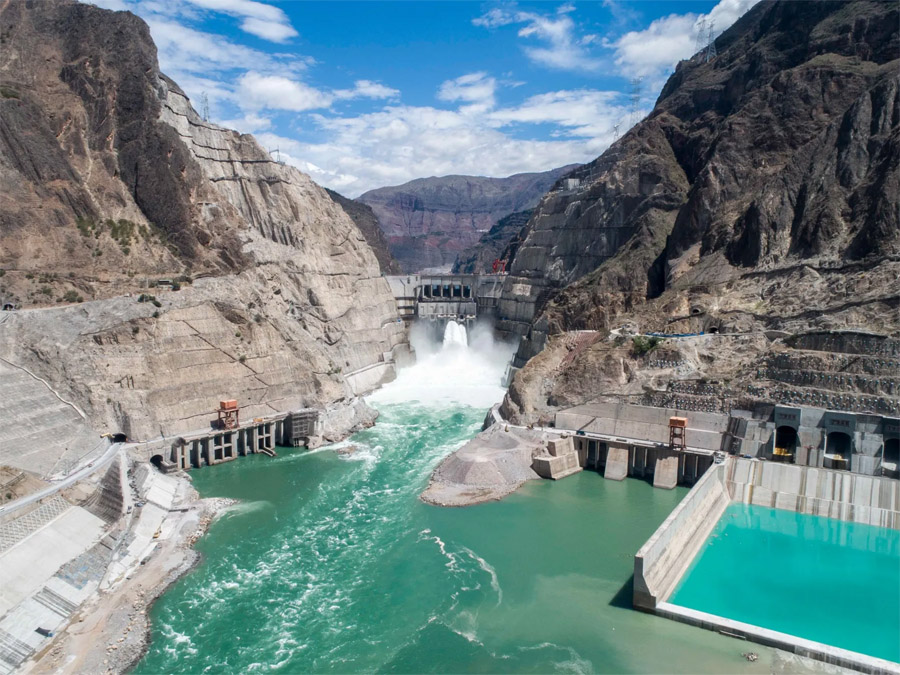Dam type hydropower stations mainly refer to hydropower stations that construct water retaining structures on rivers to form reservoirs, concentrate natural incoming water to raise water levels, and generate electricity by utilizing head differences. The main feature is that the dam and hydropower plant are concentrated in the same shorter river section.
Dam type hydropower stations generally include water retaining structures, discharge structures, pressure pipelines, power plants, turbines, generators, and ancillary equipment. Most of the water retaining structures used by dams are medium to high head hydropower stations, while those used by gates are mostly low head hydropower stations. When the water head is not high and the river channel is wide, the power plant is often used as part of the water retaining structure. This type of hydropower station is also known as a riverbed hydropower station or a dam hydropower station.
Dam type hydropower stations can be divided into two categories based on the relative position between the dam and the hydropower plant: dam behind type and riverbed type. The powerhouse of the dam type hydropower station is arranged on the downstream side of the dam body and generates electricity by diverting water through pressure pipelines. The powerhouse itself does not bear the upstream water pressure. The powerhouse, dam, spillway and other buildings of the riverbed hydropower station are all built in the riverbed and are part of the water retaining structure, which bears the upstream water pressure. This arrangement is conducive to saving the total project investment.

The dam of a dam type hydropower station is usually higher. Firstly, it utilizes high water head to increase the installed capacity of the power station, which can effectively adapt to the peak shaving requirements of the power system; Secondly, there is a large storage capacity that can regulate peak flow to alleviate downstream river flood control pressure; Thirdly, the comprehensive benefits are more significant. The disadvantage is the increased loss caused by the inundation of the reservoir area and the difficulty in relocating and resettling urban and rural residents. Therefore, dam type hydropower stations with high dams and large reservoirs are often built in areas with high mountains, canyons, large water inflow, and small inundation.
The world’s largest dam type hydropower stations that have been built are mostly concentrated in China, with the Three Gorges Dam ranking first with a total installed capacity of 22.5 million kilowatts. In addition to its enormous power generation benefits, the Three Gorges Dam also has comprehensive benefits in ensuring flood control, improving navigation, and water resource utilization in the middle and lower reaches of the Yangtze River, making it a “national treasure”.
Since the 19th National Congress of the Communist Party of China, China has built several world-renowned hydropower stations. On June 28, 2021, the first batch of units at Baihetan Hydropower Station were put into operation, with a total installed capacity of 16 million kilowatts; On June 29, 2020, the first batch of units of Wudongde Hydropower Station were put into operation for power generation, with a total installed capacity of 10.2 million kilowatts. These two hydropower stations, along with Xiluodu, Xiangjiaba, Three Gorges, and Gezhouba hydropower stations, form the world’s largest clean energy corridor, with a total installed capacity of 71.695 million kilowatts, accounting for nearly 20% of the total installed hydropower capacity in China. They provide a reliable barrier for flood control safety, shipping safety, ecological safety, water resource safety, and energy safety in the Yangtze River Basin.
The report of the 20th National Congress of the Communist Party of China proposed to actively and steadily promote carbon peak and carbon neutrality. Hydropower development and construction will usher in new development opportunities, and hydropower will also play a “cornerstone” role in energy transformation and high-quality development.
Post time: Oct-22-2024
